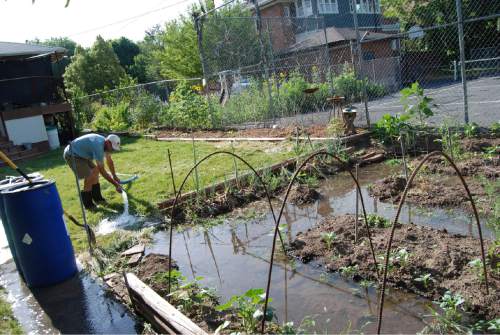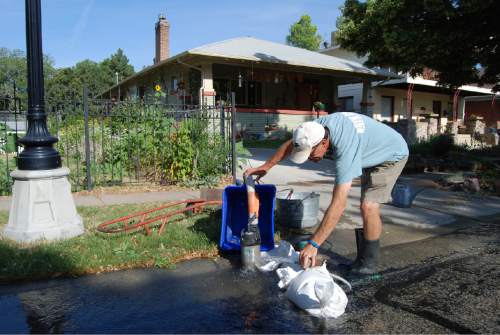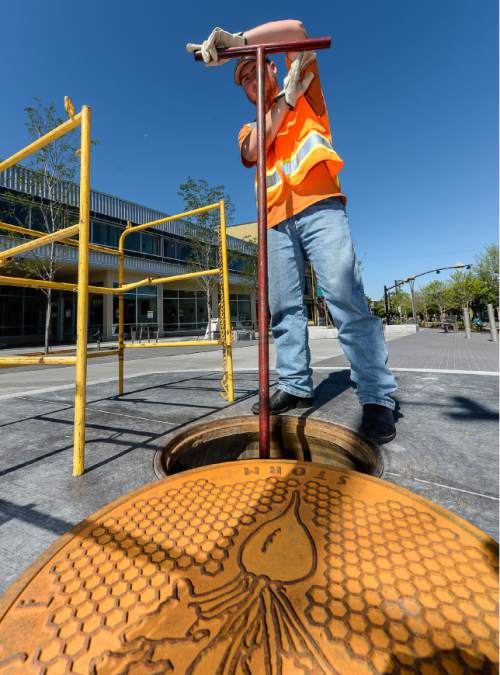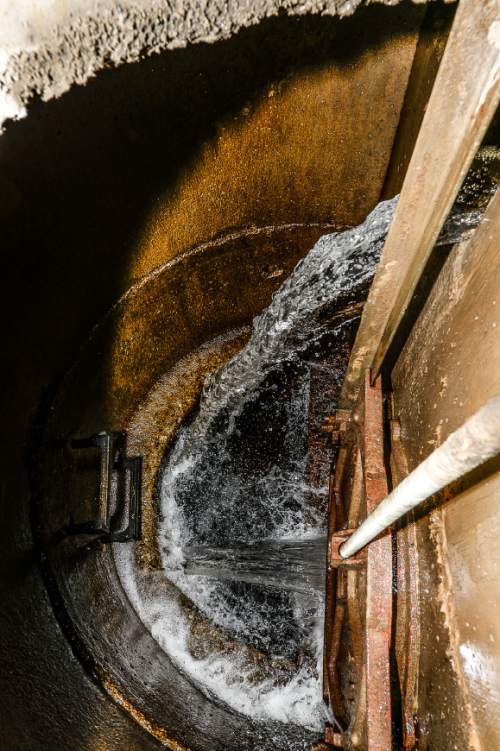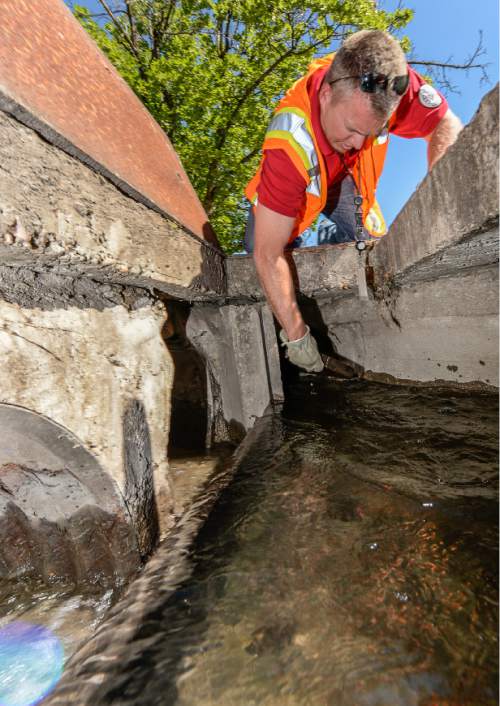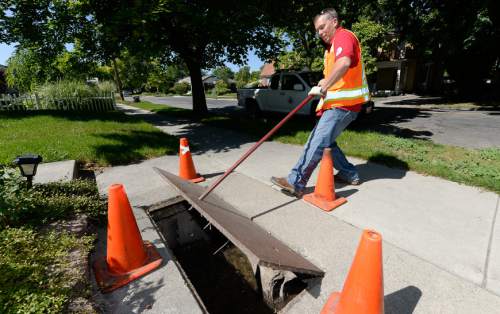This is an archived article that was published on sltrib.com in 2015, and information in the article may be outdated. It is provided only for personal research purposes and may not be reprinted.
Wednesday mornings are busy in the summertime for Reed Taylor.
He rises early to lift gates directing water from an underground irrigation canal to a concrete ditch behind his Salt Lake City property. Using hoses, he siphons the water between rows trenched through his 50-by-52-foot plot near 2100 South and 400 East.
Finally, the water gurgles and seeps its way through a cornucopia of produce that can supply an entire farmers market — pole beans, corn, tomatoes, onions, beets and several kinds of squash.
"I couldn't put a value on my garden," said Taylor, mediator for the Parleys Water Users Association.
Taylor's is just one of a network of pioneer-era ditches, structured like blood-delivering capillaries in the human body, that survive in the Salt Lake Valley, delivering irrigation water to thousands of properties that still hold water shares.
Taylor, in his 80s, is among some 162 Salt Lake City residents who still irrigate with agricultural water linked more than a century ago with the Parley's group.
The practice is a relic from the 19th century that has persisted into the 21st, due to agreements the city forged with Parleys and other irrigation companies long ago to secure a source of drinking water for a growing desert metropolis.
During summer days, irrigation water runs under and along Salt Lake City streets that have replaced the ditches. The spectacle connects Utah urban dwellers with their agricultural heritage.
But some question whether urban irrigation is a wise use of a finite and increasingly precious resource — particularly at a time when drought is stressing supplies and water districts are seeking to divert 220,000 acre-feet from the Bear River.
"There is so much inefficiency in the system," said Zach Frankel of the Utah Rivers Council. "We need to get a handle on how much water is in this agricultural system."
—
Farm water in an urban city • Not everyone using the water has a right to do so. A homeowner on Thursday was dipping buckets into a gutter near 900 East and pouring the water on her plants and fruit trees just inches from the gutter.
That, for Frankel, is precisely the problem. Irrigation, he says, is a wasteful, out-of-date way to water Kentucky bluegrass and marigolds.
While state water managers project increasing water shortages to justify the more than $2 billion pricetag for the Bear River dam system and the Lake Powell pipeline, Frankel points to the hundreds of thousands of acre feet that flow through old canals and ditches along the Wasatch Front.
Most of that water is spoken for, but Frankel and others want water managers to consider what happens to that water when farmland is retired, or irrigators become more efficient.
Agriculture consumes 82 percent of Utah's water, while accounting for 3 percent of the economy. But that is likely to change as fields and orchards disappear under subdivisions and cul-de-sacs, shopping centers, highways and office parks.
The transition is expected to free up irrigation water for municipal and industrial uses. But a recent audit concluded the state's water planners do not adequately account for the change.
"We found the Division of Water Resources was not using the correct conversion factor," legislative auditor Jim Behunin told an interim committee last month. "As a result, they were understating the amount of agricultural water that would be available in the future."
If those numbers are wrong, Frankel says, controversial water development projects like the Bear River dams or the Lake Powell Pipeline may not be necessary to meet the state's needs.
That kind of talk makes rural lawmakers nervous.
"I am concerned that they are looking at all that agricultural water," said Rep. Mike Noel, a Kanab rancher. "As a farmer, we have a $19 billion industry out there. I want to make sure it keeps going. I don't want every single drop of water going to flush people's toilets."
Frankel argues such a position is disingenuous because converting water to municipal use is not what threatens agriculture. Urban sprawl is the threat, he says. But state officials do little to slow residential development as projections suggest Utah's population will double soon after 2050.
"The water we are talking about is not in agriculture," Frankel said. "It came from agriculture, but the farms are gone. It's surplus and it's flowing in our gutters, canals and sidewalks. It's crazy to pretend that this water doesn't exist."
Commercial farming has faded in the Salt Lake Valley, but backyard gardens like Taylor's remain productive and growers who irrigate are just as protective of their water rights as Noel is.
"Most ditch shareholders are concerned about what government would do," said Richard Christiansen, an officer of the White Ditch Irrigation Co. that serves a neighborhood south of 2700 South. "We have managed our rights to irrigate our property. There is a certain amount of fear."
Unlike most Parleys users, White Ditch irrigators open and close the gates themselves and keep the ditches free of debris. Homeowners draw water from a system of lateral pipes and ditches connected to a main line that runs from a diversion on Mill Creek at Evergreen Park on 3900 South.
Each share gets 44 minutes of water per week, which deposits 2,000 to 3,000 gallons a year.
"We don't want to lose our water," Christiansen said.
—
Water-tight contracts • Flood irrigation in Utah's most urbanized valley has been waning for decades as rights holders stop irrigating or die off. Watering through a series of gates, pipes and furrows is a labor-heavy chore that many people no longer have the time and patience for.
Still, there are enough holdouts to ensure water will keep flowing through the old ditches, linking properties to five historic canals that move Utah Lake water north from diversion points at the Jordan Narrows.
Salt Lake City leaders have no choice but to continue delivering water to properties that hold water rights associated with the Parleys Water Users Association. An 1888 agreement the city struck to get mountain water from Parleys Creek locks the deal in place so long as the irrigation company has active members, according to public utilities director Jeffry Niermeyer.
Mormon pioneers established Salt Lake City as an agricultural community where home sites were platted around 10-acre farmed blocks. As homes and businesses grew in the 1870s and 1880s, water from City Creek no longer met municipal needs and then-city engineer Jesse Fox turned his sights on nearby mountains.
At the time, farmers monopolized much of the pristine water flowing from various Wasatch canyons under the West's water law system, which prioritizes those who first put water to "beneficial use."
Under a number of deals dating back 100 or more years, the city acquired the rights to Parleys, Mill Creek, Big and Little Cottonwood creeks from several irrigation companies. In exchange, the city provides substandard water from Utah Lake to the irrigation companies' shareholders via the 29-mile Jordan and Salt Lake Canal, completed in 1882. The canal ensured irrigation during droughts and late in summer, when creeks often went dry, Niermeyer said.
Now, the canals run underground in a concrete box flume. During irrigation season, watermaster Nathan Hawks goes to work at 3:30 a.m., adjusting headgates to divert water from the canal.
At the McClelland Street pocket park on Thursday, Hawks lifted the heavy steel plate concealing the gate and used a five-foot key to open it, sending water into a ditch through one backyard to a neighbor's yard.
"I have times set so they don't try to take it at the same time," Hawks said. "I check on users to ensure they are not flooding their place to the point they are not flooding a neighbor."
While the system of gates and ditches puts a lot of work on the city, the old contracts have been a huge boon to urban Utah because they provide 65,000 acre feet of mountain water that supplies 400,000 people.
Niermeyer and other water officials say the irrigation water running through the city is not suitable for drinking because of all the contaminants it picks up in Utah Lake. Treating it would be cost prohibitive.
And, they say, the water running down city gutters is not really wasted if it waters the next shareholder's garden or flows back into the Jordan River.
—
One water right at a time • Meanwhile, the city is picking up water rights from some irrigation companies — for a steep price.
The Big Cottonwood Tanner Ditch Co., for example, stopped moving water a few years ago because fewer and fewer people tapped a system that was costly to maintain, according to company officer Jim Palmer.
"It went from hundreds to less than a dozen people," said Palmer, a Holladay City Council member. "We were faced with increased liability, lawsuits from people who said our ditches flooded them. Our fear was the state engineer would come in and say you don't have beneficial use.
"So we cut a deal with the city in that we got out of the flood irrigation business," he said.
Salt Lake City water managers committed to $15 million in upgrades to Holladay's water-delivery system in exchange for a water right worth $20 million.
"We are now using more water in culinary water than we were using in flood irrigation," Palmer said.
It was a good deal, but a downside is emerging.
Water from the ditch has long sustained an arboreal greenbelt along its alignment near 6200 South. With the ditch dry for the first time, some trees, including a stately maple near Palmer's home, are dying.
Palmer, whose ancestors dug the Tanner ditches, says there is no clear answer about how to convert the Salt Lake Valley's agricultural water for use in homes.
"Does it make sense to treat and chlorinate water if we are going to pour it on the lawn?" Palmer asked. "If you pour water on the ground, are you wasting it?"
In the end, Palmer believes, maintaining the irrigation lines keeps a delicate water ecosystem in balance.
"It will end up in Great Salt Lake, which is at historic lows, mostly because of impoundments upstream," he said. "We are on the verge of harming the ecosystem because we aren't letting water get to the lake."


